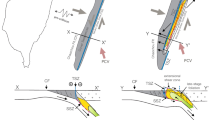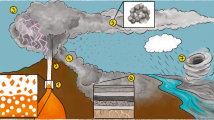Abstract
Peak intensities (magma discharge rate) of 45 Pleistocene and Holocene plinian eruptions have been inferred from lithic dispersal patterns by using a theoretical model of pyroclast fallout from eruption columns. Values range over three orders of magnitude from 1.6 × 106 to 1.1 × 109 kg/s. Magnitudes (total erupted mass) also vary over about three orders of magnitude from 2.0 × 1011 to 6.8 × 1014 kg and include several large ignimbrite-forming events with associated caldera formation. Intensity is found to be positively correlated with the magnitude when total erupted mass (tephra fall, surges and pyroclastic flows) is considered. Initial plinian fall phases with intensities in excess of 2.0 × 108 kg/s typically herald the onset of major pyroclastic flow generation and subsequent caldera collapse. During eruptions of large magnitude, the transition to pyroclastic flows is likely to be the result of high intensity, whereas the generation of pyroclastic flows in small magnitude eruptions may occur more often by reduction of magmatic volatile content or some transient change in magma properties. The correlation between plinian fall intensity and total magnitude suggests that the rate of magma discharge is related to the size of the chamber being tapped. A simple model is presented to account for the variation in intensity by progressive enlargement of conduits and vents and excess pressure at the chamber roof caused by buoyant forces acting on the chamber as it resides in the crust. Both processes are fundamentally linked to the absolute size of the pre-eruption reservoir. The data suggest that sustained eruption column heights (i.e. magma discharge rates) are indicators of eventual eruption magnitude, and perhaps eruptive style, and thus are key parameters to monitor in order to assess the temporal evolution of plinian eruptions.
Similar content being viewed by others
References
Aramaki S (1984) Formation of the Aira Caldera, Southern Kyushu, ∼22,000 years ago. J Geophys Res 89:8485–8501
Blake S (1981) Volcanism and the dynamics of open magma chambers. Nature 289:783–785
Bloomfield K, Rubio G, Wilson L (1977) Plinian eruptions of Nevado de Toluca volcano, Mexico. Geol Rund 66:120–146
Bond A, Sparks RSJ (1976) The Minoan eruption of Santorini, Greece. J Geol Soc Lond 132:1–16
Carey S, Sigurdsson H (1985) The May 18 eruption of Mount St. Helens 2. Modelling of dynamics of the plinian phase. J Geophys Res 90:2948–2958
Carey S, Sigurdsson H (1986) The 1982 eruptions of El Chichon volcano, Mexico (2): Observations and numerical modelling of tephra fall distribution. Bull Volcanol 48:127–141
Carey S, Sigurdsson H (1987) Temporal variations of column height and magma discharge rate during the 79 AD eruption of Vesuvius. Bull Geol Soc Amer 99:303–314
Carey S, Sparks RSJ (1986) Quantitative models of fallout and dispersal of tephra from volcanic eruption columns. Bull Volcanol 48:109–125
Cornell W, Carey S, Sigurdsson H (1983) Computer simulation of transport and deposition of the Campanian Y-5 ash. J Volcanol Geotherm Res 17:89–109
Druitt T, Sparks RSJ (1984) On the formation of calderas during ignimbrite eruptions. Nature 310:679–681
Elder JW (1979a) Magma traps: Part I, Theory. J Pure Appl Geophys 117:3–14
Elder JW (1979b) Magma traps: Part II, Application. J Pure Appl Geophys 117:15–33
Fedotov SA (1985) Estimates of heat and pyroclast discharge by volcanic eruptions based upon the eruption cloud and steady plume observations. J Geodynam 3:275–302
Fierstein J, Hildreth W (1986) Ejecta dispersal and dynamics of the 1912 eruptions at Novarupta, Katmai National Park, Alaska. EOS Trans Am Geophys Union 67(44): 1246
Gorshkov GS (1959) Gigantic eruption of the volcano Bezymianny. Bull Volcanol 20:77–109
Harris D, Rose WI, Roe R, Thompson M (1981) Radar observation of ash eruptions. US Geol Surv Prof Pap 1250:323–334
Hayakawa Y (1985) Pyroclastic geology of Towada Volcano. Bull Earth Res Instit Univ Tokyo 60:507–592
Hoblitt RP (1986) Observations of the eruptions of July 22 and August 7, 1980 at Mount St. Helens, Washington. US Geol Surv Prof Pap 1335:1–44
Katsui Y (1959) On the Shikotsu Pumice-fall Deposit, Special Reference to the Activity just before the Depression of the Shikotsu Caldera. Bull Volcanol Soc Japan 4(2):33–48
Kobayashi T, Hayakawa Y, Aramaki S (1983) Thickness and grain-size distribution of the Osumi pumice fall deposit from the Aira caldera. Bull Volcanol Soc Japan 28(2): 129–139
Lirer L, Pescatore T, Booth B, Walker GPL (1973) Two plinian pumice-fall deposits from Somma Vesuvius, Italy. Bull Geol Soc Am 84:759–772
Naranjo J, Sigurdsson H, Carey S, Fritz W (1986) Eruption of Nevado del Ruiz, Colombia, on 13 November 1985: Tephra fall and lahars. Science 233:961–963
Newhall C, Self S (1982) The volcanic explosivity index (VEI): an estimate of explosive magnitude for historical volcanism. J Geophys Res 87:1231–1238
Pescatore T, Sparks RSJ, Brazier S (1987) Reverse grading in the Avellino plinian deposit of Vesuvius. Bull Volcanol (in press)
Pollard D, Muller O (1976) Effect of gradients in regional stress and magma pressure on the form of sheet intrusions in cross section. J Geophys Res 81:975–984
Robson G, Barr K (1964) The effect of stress on faulting and minor intrusions in the vicinity of a magma body. Bull Volcanol 27:315–330
Rose WI, Newhall C, Bornhorst T, Self S (1987) Quaternary silicic pyroclastic deposits of Atitlan caldera, Guatemala. J Volcanol Geotherm Res 33:57–80
Rowley P, Kuntz M, Macleod N (1981) Pyroclastic flow deposits: The 1980 eruptions of Mount St. Helens, Washington. US Geol Surv Prof Pap 1250:489–512
Settle M (1978) Volcanic eruption clouds and the thermal power output of explosive eruptions. J Volcanol Geotherm Res 3:309–324
Shaw HR (1980) The fracture mechanisms of magma transport from the mantle to the surface. In: Hargraves RB (ed) Physics of magmatic processes, pp 201–232
Sigurdsson H, Carey S, Cornell W, Pescatore T (1985) The eruption of Vesuvius in A.D. 79. Nat Geograph Res 1(3):332–387
Sigurdsson H, Carey S (1989) The 1815 eruptions of Tambora, Indonesia: generation of co-ignimbrite ash fall during entrance of pyroclastic flows into the ocean. Bull Volcanol 51 (in press)
Sparks RSJ (1986) The dimensions and dynamics of volcanic eruption columns. Bull Volcanol 48:3–15
Sparks RSJ, Wilson L (1976) A model for the formation of ignimbrite by gravitational column collapse. J Geol Soc Lond 132:441–451
Sparks RSJ, Self S, Walker GPL (1973) Products of ignimbrite eruptions. Geology 1:115–118
Sparks RSJ, Wilson L, Hulme G (1978) Theoretical modeling of the generation, movement, and emplacement of pyroclastic flows by column collapse. J Geophys Res 83:1727–1739
Sparks RSJ, Wilson L, Sigurdsson H (1981) The pyroclastic deposits of the 1875 Askja eruption, Iceland. Phil Trans Roy Soc Lond 29:241–273
Sparks RSJ, Moore JG, Rice CJ (1986) The initial giant eruption cloud of the May 18, 1980, explosive eruption of Mount St. Helens. J Volcanol Geotherm Res 28:257–274
Sussman D (1985) Apoyo caldera, Nicaragua: a major Quaternary silicic eruptive center. J Volcanol Geotherm Res 24:249–282
Traineau H, Westercamp, D (1985) Les éruptions ponceuses récentes de la Montagne Pelée (Martinique) Description des dépôts-dynamique éruptifs. IMRG A.F.M.E. 85 SGN 471 IRG: 1–68
Walker GPL (1980) The Taupo pumice: products of the most powerful known (ultraplinian) eruption? J Volcanol Geotherm Res 8:69–94
Walker GPL (1981a) Plinian eruptions and their products. Bull Volcanol 44-2:223–240
Walker GPL (1981b) The Waimihia and Hatepe plinian deposits from the rhyolitic Taupo volcanic center. New Zeal J Geol Geophys 24:305–324
Walker GPL (1984) Downsag calderas, ring faults, caldera sizes, and incremental caldera growth. J Geophys Res 89:8407–8416
Walker GPL, Croasdale R (1973) Two plinian-type eruptions in the Azores. J Geol Soc Lond 127:17–55
Walker GPL, Wright JV, Clough BJ, Booth B (1981) Pyroclastic geology of the rhyolitic volcano of La Primavera, Mexico. Geol Rundsch 70:1100–1118
Walker GPL, Self S, Wilson L (1984) Tarawera 1886, New Zealand- a basaltic plinian fissure eruption. J Volcanol Geotherm Res 21:61–78
Watkins ND, Sparks RSJ, Sigurdsson H, Huang TC, Federman A, Carey S, Ninkovich D (1978) Volume and extent of the Minoan tephra from Santorini Volcano: new evidence from deep-sea cores. Nature 271:122–126
Weertman J (1971) Theory of water-filled crevasses in glaciers applied to vertical magma transport beneath oceanic ridges. J Geophys Res 76:1171–1183
Whitney J, Stormer JC Jr (1986) Model for the intrusion of batholiths associated with the eruption of large volume ash flow tuffs. Science 231:483–485
Williams SN, Self S (1983) The October, 1902 plinian eruption of Santa Maria volcano, Guatemala. J Volcanol Geotherm Res 16:33–56
Wilson L (1980) Relationships between pressure, volatile content and ejecta velocity in three types of volcanic explosions. J Volcanol Geotherm Res 8:297–313
Wilson L, Head J (1981) Ascent and eruption of basaltic magma on the Earth and Moon. J Geophys Res 86:2971–3001
Wilson CJN, Walker GPL (1985) The Taupo eruption, New Zealand I. General aspects. Phil Trans Roy Soc Lond A 314:199–228
Wilson L, Sparks RSJ, Huang TC, Watkins ND (1978) The control of volcanic column heights by eruption energetics and dynamics. J Geophys Res 83:1829–1836
Wilson L, Sparks RSJ, Walker GPL (1980) Explosive volcanic eruptions IV. The control of magma properties and conduit geometry on eruption column behaviour. Geophys J Roy Astrom Soc 63:117–148
Wright JV (1981) The Rio Caliente ignimbrite: analysis of a compound intraplinian ignimbrite from a major late Quarternary Mexican eruption. Bull Volcanol 44-2:189–212
Author information
Authors and Affiliations
Rights and permissions
About this article
Cite this article
Carey, S., Sigurdsson, H. The intensity of plinian eruptions. Bull Volcanol 51, 28–40 (1989). https://doi.org/10.1007/BF01086759
Received:
Accepted:
Issue Date:
DOI: https://doi.org/10.1007/BF01086759




